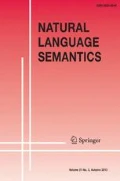Abstract
This paper provides evidence for an ambiguity of bare VPs in the English conditional conjunction construction. This ambiguity, undetected by previous researchers, provides a key to the development of a compositional semantic analysis of conditional conjunction with imperative first conjuncts. The analysis combines existing semantic theories of imperatives, the future tense, modal subordination, and speech act conjunction to yield the correct semantics without further stipulation.
Similar content being viewed by others
References
Bolinger, D. (1967). The imperative in English. In M. Halle, H. Lunt, & H. McLean (Eds.), To honour Roman Jakobson: Essays on the occasion of his seventieth birthday (pp. 335–362).
The Hague: Mouton. Chierchia, G. (2004). Scalar implicatures, polarity phenomena, and the syntax/pragmatics interface. In A. Belletti (Ed.), Structures and beyond (pp. 39–103). Oxford University Press.
Clark B. (1993). Relevance and ‘pseudo-imperatives’. Linguistics and Philosophy 16(1): 79–121
Copley, B. (2002). The semantics of the future. PhD dissertation, MIT.
Culicover P. (1970). One more can of beer. Linguistic Inquiry 1, 366–369
Culicover P.W., Jackendoff R. (1997). Semantic subordination despite syntactic coordination. Linguistic Inquiry 28(2): 195–217
Davies E.E. (1979). Some restrictions on conditional imperatives. Linguistics 17, 1039–1054
Davies E.E. (1986). The English imperative. London, Croom Helm
Franke, M. (2005). Pseudo-imperatives. Master’s thesis, Universiteit van Amsterdam.
Groenendijk, J., & Stokhof, M. (1990). Dynamic Montague Grammar. Technical Report LP-90-02, Institute for Language, Logic and Information, University of Amsterdam.
Hamblin C.L. (1987). Imperatives. London, Blackwell Publishers
Han C.-H. (2000). The structure and interpretation of imperatives. New York, Garland
Huntley M. (1984). The semantics of English imperatives. Linguistics and Philosophy 7(2): 103–133
Kratzer A. (1991a). Conditionals. In von Stechow A., Wunderlich D. (eds). Semantics: An international handbook of contemporary research. Berlin, de Gruyter, pp. 651-656
Kratzer A. (1991b). Modality. In: von Stechow A., Wunderlich D. (eds). Semantics: An international handbook of contemporary research. Berlin, de Gruyter, pp. 639-650
Krifka M. (2001). Quantifying into question acts. Natural Language Semantics 9(1): 1–40
Lewis D.K. (1975). Adverbs of quantification. In Keenan E.L. (ed). Formal semantics of natural language. Cambridge, Cambridge University Press, pp. 3-15
Linebarger M.C. (1987). Negative polarity and grammatical representation. Linguistics and Philosophy 10(3): 325–387
Mastop, R. J. (2005). What can you do? Imperative mood in semantic theory. PhD dissertation, Universiteit van Amsterdam.
Partee B., Rooth M. (1983) Generalized quantifiers and type ambiguity. In Bäuerle R., Schwarze C., von Stechow A. (eds). Meaning, use, and interpretation of language. Berlin, de Gruyter, pp. 361-383
Portner, P. (2004). The semantics of imperatives within a theory of clause types. In K. Watanabe & R. Young (Eds.), Proceedings of Semantics and Linguistic Theory 14. Ithaca, NY: CLC.
Potsdam E. (1998). Syntactic issues in the English imperative. New York, Garland
Roberts C. (1989). Modal subordination and pronominal anaphora in discourse. Linguistics and Philosophy 12(6): 683–721
Russell, B. (2005). Conditional coordination. Manuscript, Brown University.
Schmerling, S. F. (1980). On the syntax and semantics of English imperatives. Manuscript, University of Texas at Austin.
Thomason R.H. (1970). Indeterminist time and truth-value gaps. Theoria 36, 246–281
van der Auwera J. (1986). Conditionals and speech acts. In Traugott E., ter Meulen A., Reilly J. (eds). On conditionals. Cambridge, Cambridge University Press, pp. 197-214
Author information
Authors and Affiliations
Corresponding author
Additional information
This paper benefitted tremendously from the helpful comments of two anonymous reviewers and the audience at the 2005 Southern New England Workshop in Semantics, as well as from discussions with Kai von Fintel and Julie Sedivy, who served on the committee for an earlier paper from which the present paper developed. Most importantly, I thank Polly Jacobson for her insight and invaluable advice. Of course, all errors are my own.
Rights and permissions
About this article
Cite this article
Russell, B. Imperatives in conditional conjunction. Nat Lang Semantics 15, 131–166 (2007). https://doi.org/10.1007/s11050-007-9012-0
Published:
Issue Date:
DOI: https://doi.org/10.1007/s11050-007-9012-0




